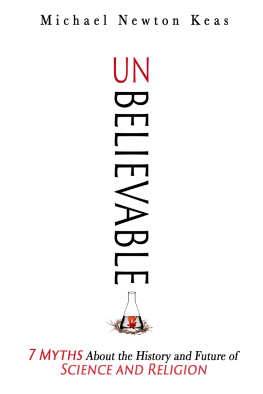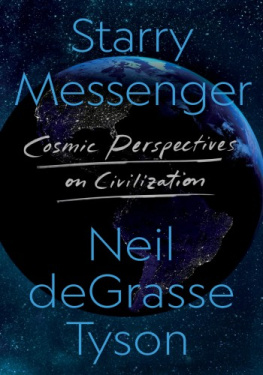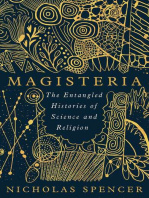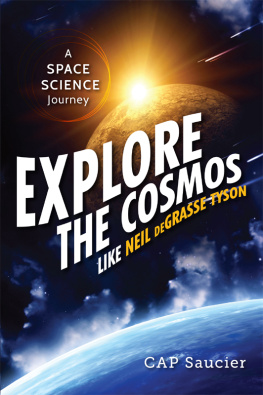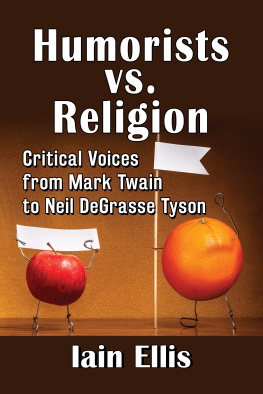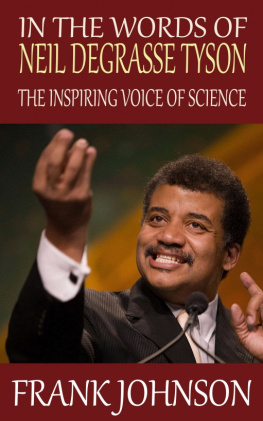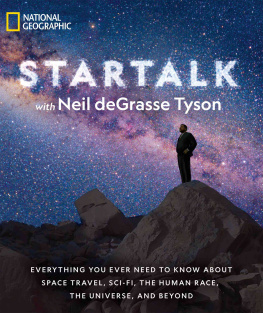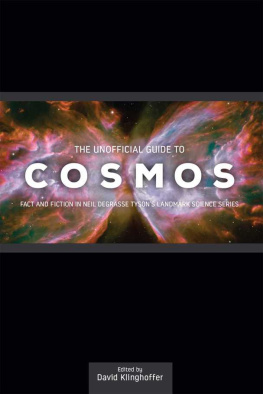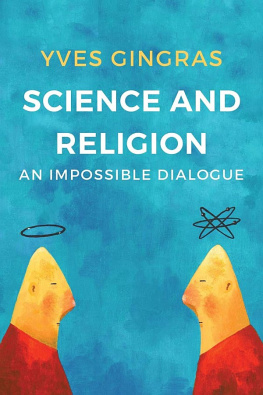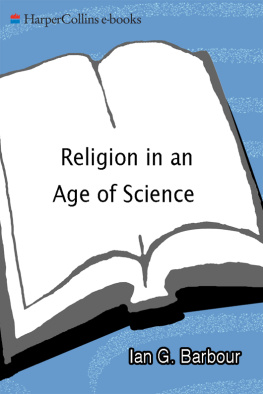
Unbelievable
7 Myths About the History and Future of Science and Religion
Michael Newton Keas

For my extended family, especially my grandfather Newton Watson Keas
Also for John, Edna, Chris, Martin, and Loetta
Contents
Introduction
The Truth Is Out There
As much as any other human enterprise, science needs stories to portray its origin and development, to glorify its heroes, to dramatize its methods and values, and to proclaim its place in human civilization.
Gregory Schrempp, The Ancient Mythology of Modern Science: A Mythologist Looks (Seriously) at Popular Science Writing (2012)
As members of the human race, we are currently the only highly intelligent beings in our corner of space. We have looked around, peered out from our earthly platform, and discovered the universe. We have mapped it and deciphered much of its history. Maybe we are the first to do so. Maybe the universe... has slept in ignorance of itself these aeons until suddenly in a few years mankinds curiosity... has opened its cosmic eyes and the universe has seen itself for the first time. Maybe we are the brains of this outfit.... We are like Robinson Crusoe, stranded on a cosmic island, not knowing whether or not we are alone until we can see the footprints in the sand.
Paul Hodge, Concepts of Contemporary Astronomy (1979)
Scientists enjoy telling stories. They tell stories about, among other things, the quest to understand the universestories that sometimes have implications for belief or disbelief in God or a spiritual heaven.
Too often, however, these stories are false. They are nothing but myths. And yet some leading scientists and science writers offer these stories as unassailable truth. The myths make their way into science textbookswhich is a useful measure of a myths influence, as we will see in this book. They also enter popular culture, whereby the myths pass as accepted wisdom.
This book examines seven of the most widespread and influential science myths. These myths concern the relationship between science and religion, especially Christianity. More specifically, the stories depict religion and science as being perpetually at odds.
In our time, history is commonly abused for polemical purposes, wielded as a long sword in the culture wars. The cultural wave known as the New Atheism has grossly distorted the history of science and religion. Yet atheist activists are far from alone in misleading the public. Prominent scientists and science educatorsincluding influential popularizers such as Bill Nye the Science Guy, the late Carl Sagan, and Neil deGrasse Tysonlead the chorus of voices portraying Christianity as anti-science, and science as liberating us from religious dogma.
But that narrative is deeply flawed. Sometimes those who champion the misleading narrative acknowledge its holes. As chapter 9 will show, one prominent historian and philosopher of science thinks that it might be permissible to offer an inaccurate history of science for an ideological-political greater truth. He even suggests granting science educators an artistic license to lie.
Taking such a morally ambiguous approach to the history of science is disturbing and dangerous. This book corrects the record, revealing the truth that the proliferation of myths has obscured.
So in addition to debunking seven pervasive myths about science and religion, I will present a more accurate, and I hope more interesting, history of how science and religion interact.
The popular science fiction TV series, and later movie, The X-Files had a famous tagline that suggested a conspiracy to cover up evidence of extraterrestrial life and the paranormal: The Truth Is Out There.
It certainly isbut not in the way the tagline suggests. The truth about science, and even about the likelihood of extraterrestrial life, is there for us to see. But first we need to clear away the myths that have done so much to confuse our understanding about science, religion, and our place in the universe.
Seven Myths, Debunked
Youve probably heard many of the myths I examine in this book. These seven stories are widely known and accepted even though they rely on exaggerations at best and completely distort the facts at worst.
The first six myths relate to the history of science and religion. The seventh is subtly connected to the six historical myths but imagines a future far removed from what we know today.
Myth #1: Premodern scholars in the Western tradition thought the universe was smalla cozy little place just for human benefit. Modern science displaced this Church-sanctioned belief with a vast cosmos that revealed humans to be insignificant.
The truth: Even ancient thinkers recognized that the earth was tiny in relation to the immense cosmos. In any case, size doesnt necessarily mean significance, as many theologians and philosophers recognized.
Myth #2: The medieval Catholic Church suppressed the growth of science, causing Europe to descend into the Dark Ages.
The truth: The medieval Catholic Church positively influenced science and other intellectual pursuits. There were no Dark Ages.
Myth #3: Because of Church-induced ignorance, European intellectuals believed in a flat earth until Columbus proved earths roundness in 1492.
The truth: Ancient and medieval intellectuals in the Western tradition had many evidence-based reasons for belief in earths roundness.
Myth #4: Giordano Bruno became a martyr for science when the Catholic Church burned him at the stake because he supported Nicolaus Copernicuss contention that the sun, not the earth, occupied the center of the universe, and because he believed in extraterrestrial life.
The truth: Brunos execution occurred almost entirely for theological reasons, not scientific ones.
Myth #5: The Church jailed Galileo Galilei because it rejected his telescopic observations and rational arguments that had proved the Copernican system.
The truth: Most early modern astronomers up through the mid-seventeenth century resisted a moving earth primarily for scientific, not theological, reasons. Galileo failed to prove that earth orbited the sun (that came later).
Myth #6: Copernicus demoted humans from the privileged center of the universe and thereby challenged religious doctrines about human importance.
The truth: Copernicus (a canon in the Catholic Church) and most of his scientific successors up through the nineteenth century considered his sun-centered astronomy to be compatible with Christianity and human exceptionalism. In fact, early Copernicans viewed earths new location not as a demotion for humanity but rather as a promotion, out of the bottom of the universe.
Myth #7: If and when we encounter extraterrestrial life, it will deal the death blow to certain religions, especially Christianity, with its doctrine of the unique incarnation and redemptive work of Gods Son on earth. Any ET capable of traveling a vast distance to earth would have superintelligence, technology indistinguishable from magic, and moral-spiritual insights that would trigger global religious reorientation.
The truth: Many Christian thinkers have been open to the possibility of extraterrestrial life, and neither a single pope nor a major church council ever declared these ideas heretical. ET and Christianity are potentially compatible.
These myths did not arise coincidentally. In part two of this book we will dig deeper, exposing the sources, real and imagined, for the origin and perpetuation of the myths. Science fiction has contributed, as have popular science communicators. In the process, we will see that religion and science need not war with each otherand didnt for centuries. We will also see that these misleading narratives did not gain traction until relatively recently.
Next page
